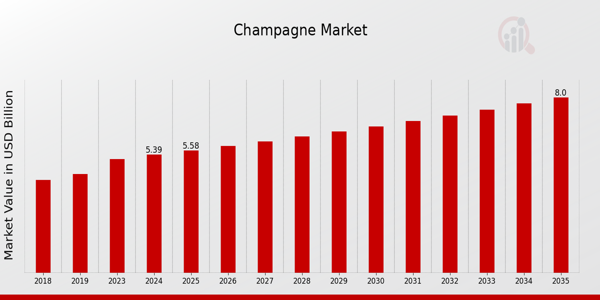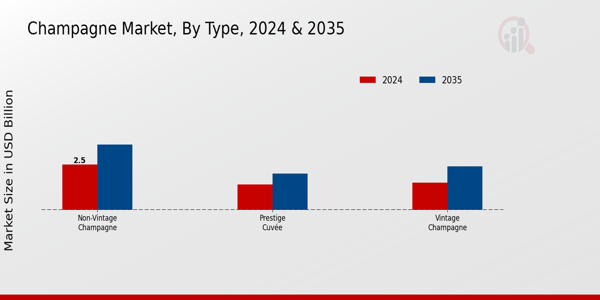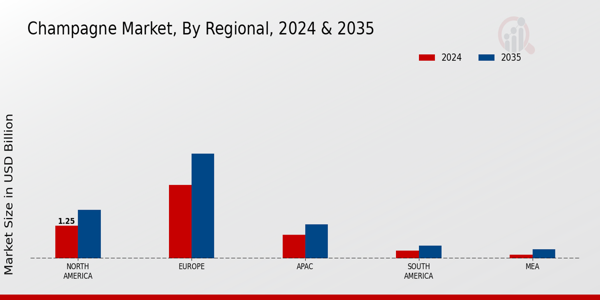Global Champagne Market Overview
Champagne Market Size was estimated at 5.2 (USD Billion) in 2023. The Champagne Market Industry is expected to grow from 5.39(USD Billion) in 2024 to 8 (USD Billion) by 2035. The Champagne Market CAGR (growth rate) is expected to be around 3.66% during the forecast period (2025 - 2035).

Source Primary Research, Secondary Research, MRFR Database and Analyst Review
Key Champagne Market Trends Highlighted
The Champagne Market is currently witnessing several important trends that reflect shifting consumer behaviors and preferences. One key market driver in this sector is the growing demand for premium and luxury beverages, particularly among millennials and younger consumers who are increasingly willing to spend on high-quality products for special occasions and celebrations. The rise of social media has further fueled this trend as consumers share their experiences and showcase their purchases, creating a desire for exclusive and trendy brands. Opportunities to be explored within the market include the expansion of product offerings, such as the introduction of organic and sustainable champagnes, which cater to the growing consumer preference for environmentally friendly products.
A more conscientious segment of the market can be attracted to brands that emphasize these attributes. Additionally, the expansion of e-commerce presents a substantial opportunity for Champagne producers to access new markets and expand their audience on a scale, thereby simplifying the process for consumers who prefer online purchasing. Recent trends suggest that the prevalence of innovative champagne approaches, such as new aging methods and unique blends, is on the rise. These approaches are appealing to adventurous consumers who are in search of unique flavors. Furthermore, the younger demographic is demonstrating an increasing interest in champagne-infused cocktails, which has resulted in the development of innovative mixology that incorporates champagne into invigorating and inventive beverages.
This trend underscores the adaptability of champagne and promotes its consumption beyond formal occasions. In general, the Champagne Market is undergoing a rapid transformation, which is being fueled by consumer preferences and innovation opportunities that are in accordance with contemporary lifestyles.
Champagne Market Drivers
Rising Popularity of Luxury Lifestyle Products
The Champagne Market Industry is experiencing significant growth due to the rising popularity of luxury lifestyle products. As disposable incomes increase globally, consumers are increasingly indulging in premium products such as champagne. According to the wealth report, the number of high-net-worth individuals (HNWIs) has risen by approximately 6.3% annually in recent years, particularly in regions like North America and Europe, aligning with the increasing demand for luxury goods.
Additionally, major luxury brands such as Moet Hennessy, part of LVMH, are capitalizing on this trend by expanding their premium offerings and marketing campaigns to enhance luxury branding. The emphasis on upscale consumption is expected to further fuel market growth as affluent consumers continue to seek out high-quality champagne products for celebrations and events.
Growth in Social Events and Celebrations
The Champagne Market Industry is significantly driven by the increasing number of social events and celebrations across various cultures. Events such as weddings, anniversaries, and corporate parties are becoming increasingly prevalent, creating a surge in champagne demand. Statistics indicate that the wedding industry alone is projected to reach a market size of USD 350 billion globally by 2025. Major players in the champagne market, such as Perrier-Jouet and Veuve Clicquot, are focusing on tailored marketing strategies targeting event planners and hosts, which in turn boosts champagne sales.
This growing trend of social gatherings inherently increases the consumption of champagne as it is often considered a quintessential celebratory drink.
The Influence of Social Media and Digital Marketing
Social media platforms are increasingly influencing consumer purchasing behavior, particularly among younger demographics. The Champagne Market Industry is benefitting from digital marketing campaigns that showcase champagne as a trendy and fashionable beverage choice. Data from recent surveys suggest that approximately 70% of millennials and Gen Z consumers are influenced by social media in their purchase decisions. Brands like Veuve Clicquot have successfully utilized platforms such as Instagram and TikTok to engage with younger audiences, thus driving sales.
The rise of influencer partnerships has also become a crucial factor, enhancing brand visibility and fostering a lifestyle connection with champagne consumption, ultimately contributing to market growth.
Champagne Market Segment Insights
Champagne Market Type Insights
The Champagne Market, segmented by Type, showcases a diverse range of products contributing to its overall growth. As of 2024, the estimated revenue for Non-Vintage Champagne stands at 2.5 USD Billion, making it the largest segment within the market, holding a significant majority in consumer preference due to its accessibility and consistent quality. This type appeals to a broader audience, being frequently used for celebratory occasions and everyday indulgence. Vintage Champagne, valued at 1.5 USD Billion in 2024, illustrates a more niche segment, often commanding higher price points due to its unique aging process, thus catering to connoisseurs looking for premium quality and distinct flavor profiles resulting from specific grape harvests.
Prestige Cuvée, with a valuation of 1.39 USD Billion, represents exclusive offerings from premier Champagne houses renowned for their exquisite craftsmanship and limited production, hence contributing to its appeal among collectors and luxury consumers. In the context of Champagne Market statistics, these segments reflect evolving consumer trends, with increasing interest in authentic and premium experiences driving demand for Vintage and Prestige Cuvée options. The importance of Non-Vintage Champagne in overall market dynamics cannot be understated, as it serves as the entry point for many new consumers into the Champagne culture.
This varied segmentation enables producers to cater to distinct consumer preferences, ultimately enhancing market growth and expanding the consumer base across diverse demographics. The blend of taste, quality, and occasion-driven consumption is expected to sustain this upward trajectory in the Champagne Market.

Source Primary Research, Secondary Research, MRFR Database and Analyst Review
Champagne Market Sales Channel Insights
The Champagne Market revenue exhibits a diverse and evolving landscape within the Sales Channel segment as it adapts to dynamic consumer preferences and buying behaviors. In 2024, the market is set to reach a valuation of USD 5.39 billion, reflecting a steady growth trajectory. Among the various sales channels, Online Retail has emerged as a prominent player, driven by the convenience of home delivery and increasing digital penetration. Supermarkets continue to account for a substantial portion of sales due to their accessibility and varied product offerings, making them a key component in the Champagne Market segmentation.
Specialty Stores hold a unique position, often providing premium and niche champagne selections that cater to discerning consumers. Additionally, Duty-Free Shops significantly attract international travelers looking for luxury items, contributing to the overall market growth. Collectively, these channels showcase the evolving landscape of consumer preferences, with online and specialty retailing gaining critical importance in shaping market dynamics, driven by trends in digital shopping and the desire for premium products. The market presents considerable opportunities as consumer demand for diverse champagne experiences continues to rise.
Champagne Market Occasion Insights
The Champagne Market valuation is expected to reach 5.39 USD Billion by 2024, demonstrating the sector's consistent demand largely fueled by key occasions such as Weddings, Corporate Events, Celebrations, and Gifts. The Weddings segment is particularly significant, as couples increasingly prioritize quality and luxury in their celebrations, leading to a steady preference for premium champagne selections. Corporate Events also play a crucial role, as businesses often use champagne to enhance brand image and foster networking opportunities.
Celebrations, including holidays and milestone events, contribute greatly to the market as consumers look for ways to elevate these moments with sparkling wines. The gifting segment shows promising growth, reflecting a cultural trend where champagne is regarded as a thoughtful present for various occasions. Overall, the segmentation within the Champagne Market highlights diverse consumer preferences and the importance of different occasions, while the anticipated market growth is supported by rising disposable incomes and a growing taste for luxury beverages.
Champagne Market Flavor Profile Insights
The Champagne Market is experiencing defined growth, particularly within the Flavor Profile segment, which contributes significantly to the overall market dynamics. By 2024, the market was valued at 5.39 USD Billion, reflecting strong demand for varied champagnes across different flavor profiles. Among these, Brut and Extra Brut are increasingly popular for their crisp and dry characteristics, appealing to sophisticated consumers. Demi-Sec, with a hint of sweetness, attracts a wider audience during celebratory occasions and enhances its market footprint considerably.
Meanwhile, Rosé is gaining traction due to its versatility and vibrant aesthetics, making it a favorite choice for younger demographics. The preference for diverse flavor profiles is driven by changing consumer tastes and heightened interest in premium and unique experiences, leading to innovation in the Champagne industry. Such segmentation allows producers to cater effectively to varying preferences and maintain a competitive edge in the market. According to Champagne Market statistics, these flavor profiles continue to shape consumer choices, thereby steering overall market growth.
Additionally, the rising trend of social gatherings and enhanced lifestyle experiences further fosters robust opportunities amid challenges such as economic fluctuations and changing regulations.
Champagne Market Regional Insights
The Regional segment of the Champagne Market exhibits diverse dynamics across various areas, reflecting differing consumer preferences and market maturity. In 2024, North America is expected to hold a market valuation of 1.25 USD Billion, which is projected to rise to 1.85 USD Billion by 2035, indicating a steady growth driven by an increasing trend of premiumization among consumers. Europe remains the largest market, valued at 2.8 USD Billion in 2024 and anticipated to reach 4.0 USD Billion in 2035, dominating due to its rich wine culture and established consumer base.
The APAC region is also on an upward trajectory, with valuations projected from 0.9 USD Billion in 2024 to 1.3 USD Billion by 2035, as countries like China and Japan experience a burgeoning interest in Western luxury products. South America, though smaller, shows potential growth as it increases from 0.3 USD Billion in 2024 to 0.5 USD Billion in 2035, driven by young and vibrant demographics exploring premium segments. Meanwhile, the MEA market, valued at 0.14 USD Billion in 2024, is set to grow to 0.35 USD Billion by 2035, reflecting a slow but emerging interest in luxury brands in a developing economic landscape.
Overall, the European market holds the majority, significantly shaping trends and consumption habits in the Champagne Market.

Source Primary Research, Secondary Research, MRFR Database and Analyst Review
Champagne Market Key Players and Competitive Insights
The Champagne Market has long been characterized by its blend of tradition, luxury, and innovation. As a niche sector within the broader wine and spirits industry, it features a range of players from established legacy brands to innovative newcomers seeking to capture a piece of the growing interest in premium sparkling wines. The competition in this market is intensified by factors like brand reputation, quality, exclusivity, and marketing strategies. With rising consumer interest in high-end experiences, producers are increasingly focusing on limited editions, artisan methods, and heritage narratives to differentiate themselves. Understanding competitive insights reveals critical dynamics like pricing strategies, distribution channels, and consumer preferences that shape the positioning of various brands, allowing them to navigate this unique landscape effectively.
Charles Heidsieck holds a distinguished position in the Champagne Market, recognized for its commitment to quality and artisanal craftsmanship. The brand's strengths lie in its rich heritage, with a history that dates back to the mid-19th century and a reputation that emphasizes elegance and refinement. Its production techniques include long aging processes and meticulously sourced grapes from top-rated vineyards, which contribute positively to its market presence. The brand successfully leverages its unique selling proposition through marketing strategies that highlight its legacy and quality. This not only appeals to connoisseurs of fine champagnes but also attracts consumers looking for an authentic and luxurious beverage experience. Moreover, the brand's consistent quality and innovative approach to blending make it a formidable player in the highly competitive landscape of the champagne industry.
Moet Hennessy, a leader in the Champagne Market, is synonymous with luxury and prestige. The company boasts an extensive portfolio of well-regarded champagne brands, most notably its flagship products that consistently receive accolades for their quality and innovativeness. Moet Hennessy employs strategic marketing channels, leveraging distribution networks and partnerships to enhance brand visibility and reach. Strengths of the company include strong financial backing, enabling substantial investments in both product development and marketing initiatives, and ensuring its products are at the forefront of consumer trends. The company is also known for key mergers and acquisitions that have expanded its influence and market share in the arena. Moet Hennessy's commitment to sustainability and craftsmanship further distinguishes its offerings, attracting a diverse customer base and reinforcing its position as a powerhouse in the champagne sector.
Key Companies in the Champagne Market Include
- Charles Heidsieck
- Moet Hennessy
- Bollinger
- Chandon
- LaurentPerrier
- Cristal
- Dom Perignon
- H. Mumm
- Taittinger
- Freixenet
- Veuve Clicquot
- Cattier
- Louis Roederer
- Perrier Jouet
- Ruinart
Champagne Market Industry Developments
Recent developments in the Champagne Market show a significant rise in luxury consumer demand, emphasizing premium brands such as Moet Hennessy and Veuve Clicquot. In late 2022, Charles Heidsieck reported a stellar growth rate, increasing its market share amid rising interest in high-quality Champagne. Furthermore, in January 2023, Louis Roederer announced expansion plans into the Asian market, targeting growth in China, where Champagne consumption is on the rise. Notably, the collaboration between G.H. Mumm and Ruinart to enhance sustainability practices has gained attention, reflecting a broader trend in the industry towards eco-friendly practices.
As for mergers and acquisitions, there have been no significant updates reported this year. In recent years, reviews from 2021 indicated increased interest among major players in acquiring smaller vineyards to enhance portfolio diversity. Major market shifts have occurred, notably in 2020, when the COVID-19 pandemic severely impacted sales channels, forcing brands to innovate and adopt e-commerce as a primary sales strategy. The market valuation of the Champagne sector continues to grow as consumer trends shift towards luxury products, fostering competitive dynamics among established brands like Bollinger and Laurent-Perrier.
Champagne Market Segmentation Insights
-
Champagne Market Type Outlook
- Non-Vintage Champagne
- Vintage Champagne
- Prestige Cuvée
-
Champagne Market Sales Channel Outlook
- Online Retail
- Supermarkets
- Specialty Stores
- Duty-Free Shops
-
Champagne Market Occasion Outlook
- Weddings
- Corporate Events
- Celebrations
- Gifts
-
Champagne Market Flavor Profile Outlook
- Brut
- Demi-Sec
- Extra Brut
- Rose
-
Champagne Market Regional Outlook
-
North America
-
Europe
-
South America
-
Asia Pacific
-
Middle East and Africa
Report Scope:
| Report Attribute/Metric Source: |
Details |
| MARKET SIZE 2023 |
5.2(USD Billion) |
| MARKET SIZE 2024 |
5.39(USD Billion) |
| MARKET SIZE 2035 |
8.0(USD Billion) |
| COMPOUND ANNUAL GROWTH RATE (CAGR) |
3.66% (2025 - 2035) |
| REPORT COVERAGE |
Revenue Forecast, Competitive Landscape, Growth Factors, and Trends |
| BASE YEAR |
2024 |
| MARKET FORECAST PERIOD |
2025 - 2035 |
| HISTORICAL DATA |
2019 - 2024 |
| MARKET FORECAST UNITS |
USD Billion |
| KEY COMPANIES PROFILED |
Charles Heidsieck, Moet Hennessy, Bollinger, Chandon, LaurentPerrier, Cristal, Dom Perignon, G.H. Mumm, Taittinger, Freixenet, Veuve Clicquot, Cattier, Louis Roederer, Perrier Jouet, Ruinart |
| SEGMENTS COVERED |
Type, Sales Channel, Occasion, Flavor Profile, Regional |
| KEY MARKET OPPORTUNITIES |
Premiumization trend among consumers, Increasing demand in emerging markets, Growth of e-commerce channels, Expansion of organic and sustainable options, Rising popularity of champagne cocktails |
| KEY MARKET DYNAMICS |
Growing premiumization trend, Increasing demand for organic options, Rise of e-commerce sales, Expanding millennial consumer base, Regional variations in consumption |
| COUNTRIES COVERED |
North America, Europe, APAC, South America, MEA |
Champagne Market Highlights:
Frequently Asked Questions (FAQ) :
The Global Champagne Market is expected to be valued at 5.39 billion USD in 2024.
By 2035, the Global Champagne Market is projected to reach a value of 8.0 billion USD.
The expected CAGR for the Global Champagne Market from 2025 to 2035 is 3.66.
In 2024, Europe is expected to hold the largest market share with a valuation of 2.8 billion USD.
The market size for Non-Vintage Champagne is expected to be 3.6 billion USD in 2035.
Major players in the Global Champagne Market include Moet Hennessy, Bollinger, Veuve Clicquot, and Dom Perignon.
The market size of Vintage Champagne is projected to be valued at 1.5 billion USD in 2024.
The APAC region is expected to reach a market size of 1.3 billion USD by 2035.
The anticipated market value of Prestige Cuvée in 2024 is estimated to be 1.39 billion USD.
The Global Champagne Market presents growth opportunities particularly in emerging markets and by targeting younger consumers.

















